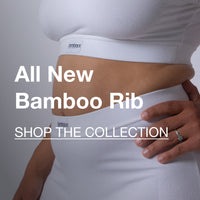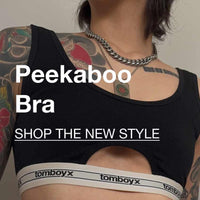Androgynous Fashion - Everything You Need To Know
In 2022, we are seeing a rise in the popularity and celebration of androgynous fashion in the fashion industry. Celebrities like Jaden Smith and Janelle Monáe are rocking looks that push gender norms and embrace fluidity –– and we can’t get enough of it.
But genderless looks from your favorite fashion brands extend far past the realm of stars and style icons; fortunately, it’s becoming easier to find androgynous styles for everybody nowadays.
If you’re new to the world of androgynous fashion –– or a seasoned expert wanting to brush up on some of their knowledge –– you’ve come to the right place.
Here’s a brief breakdown of what it means to dress androgynously and how this style has evolved:
What Is Androgynous Fashion?
Genderless fashion is often defined in different ways. On the one hand, one can regard it as a style that combines both masculine and feminine elements, blurring the lines between the two. On the other hand, some might say that gender-fluid fashion aims to be completely gender-neutral clothing, forsaking any sort of gendered labels.
Origins and Evolution of Androgynous Fashion
Unisex styles in the United States and Europe experienced a surge of popularity in the 1960s; this was partially in response to the extreme and strictly defined gender roles that abounded in the 1950s.
Space Age Styles in Paris
Avant-garde Parisian designers created “Space Age” styles; these were functional and sleek looks made of synthetic patterns (think Star Trek). These unisex clothes appeared to look into an egalitarian, utopian future. In contrast to the fashion styles of the decade before (strictly gendered menswear and womenswear), the fashion trends of the 60s embraced a more futuristic look.
The response to androgynous styles worn by actresses, singers, and other stars at the time was mixed –– some were against them, while others praised the more progressive and inclusive shift.
There was also a movement for gender-neutral child rearing during the 70s, which seemed to largely fizzle out by the 80s. Not everybody was able to adopt genderless styles, even if they wanted to; being a member of the LGBTQ+ community was something many had to keep under wraps during this time.
Small Steps Forward in the 1960s and 1970s
With the exception of some eccentric celebrity styles, however, a lot of the gender-neutral fashion of the 60s and 70s veered in a masculine direction. There was still a lot of progress to be made in terms of gender inclusivity.
During this time, fashion designer Yves St. Laurent created a line of menswear-inspired jackets and tuxedos as a women’s wear line, for example. This tomboy-esque trend in women’s fashion coincided with more women entering the workforce and second-wave feminism.
There were some more gender-neutral styles that catered towards men as well. For example, Nehru jackets, along with baggy tunics, turtleneck sweaters, blazers, and vests, were somewhat more androgynous alternatives to the typical suit. Both men and women of all body types wore these styles.
The 1990s to Today: More Popular Than Ever
Androgynous fashion found a bit of a resurgence in the 1990s, both on the red carpet and in everyday streetwear. The grunge music scene featured ripped jeans, flannels, and band tees that were worn across the gender spectrum. Nirvana frontman Kurt Cobain was a part of this trend, often wearing eyeliner and dresses during shows and photoshoots.
Today, genderless fashions can be seen in designer couture showrooms as well as everyday street and professional styles.
A Look at Some Androgynous Fashion Icons
One helpful way to gather androgynous style inspiration is to look to style icons of the past and the present. Here are a few noteworthy stars who helped bring androgynous fashion into the public eye.
David Bowie
With his skintight suits, platform boots, and colorful makeup, David Bowie blurred gender boundaries. Particularly in the 1970s, his alter ego Ziggy Stardust donned eccentric looks that were equal parts playful, theatrical, sensual, and alien. He even inspired designers such as Alexander McQueen and Jean-Paul Gaultier to create androgynous looks.
Kurt Cobain
Kurt Cobain may not be as recognized today for his androgynous styles as his other musical peers, but 90s grunge featured a lot of genderless clothing. Cobain himself liked to sport house dresses, gowns, and tiaras. Cobain’s looks subtly blurred gender lines; he insisted that comfort was of utmost importance to him.
Prince
Prince took the pop music scene by storm in sequined jumpsuits, ruffled blouses, and shiny fabrics. Many have recognized how his androgynous style pushed boundaries in the 80s and 90s.
It also brought androgynous sensuality to the forefront. His many outfits spanned the entirety of the rainbow, proving that colors don’t need to be tied to any gender limitations.
Grace Jones
Grace Jones has been a muse to many designers and androgynous fashion enthusiasts. The model and musician began her career in the 1970s and has since become known for her striking, statuesque frame, rebellious nature, and gender-defying looks.
Her flattop hairstyle and eccentric androgynous outfits made her known amongst the fashion world as well as the LGBTQ+ community.
Marlene Dietrich
This one goes way back, but Marlene Dietrich has long been recognized for pushing the gender boundaries of the 1920s and 30s. Dietrich famously wore tuxedos to film premieres and in her movies, most notably Morocco, in which she also kissed another woman. Yves Saint Laurent has cited her as a source of inspiration for his androgynous designs.
Who Can Wear Androgynous Fashion?
Androgynous fashion is for everyone. That’s sort of the point: Genderless fashion is not attached to any kind of specific kind of identity. While some individuals who rock androgynous styles may identify with labels like non-binary or gender-fluid, anybody can wear genderless styles regardless of personal labels.
Androgyny, in the fashion sense, does not correspond to a specific gender identity (or lack of one). It is simply a matter of style and personal taste. You can choose to dress androgynously all the time, or you can try it out when you feel like it. You may be the edgy type who likes pushing fashion boundaries –– like the pop music icons of androgynous fashion history –– or just someone who prefers gender-neutral looks that are simple and flattering.
Where Can You Find Androgynous Clothing?
Androgynous fashion seems to be more accessible today than ever before. Many brands and stores are adding genderless categories to their websites and physical locations; some designers are coming out with entire genderless or unisex lines and collections.
Some brands do away with gendered labels entirely. These can be easy go-to for finding androgynous options. At tomboyx, we provide clothes and undergarments that are tailored to certain wants and needs rather than specific genders.
That means you can find a long list of clothes that are both gender-inclusive and gender-affirming. Whether you are looking for something to wear to the pool, gym, or just for your everyday activities, there is no shortage of gender-neutral styles.
Androgynous Fashion of Today: The Takeaway
With more and more people becoming aware of gender diversity and identities, dressing androgynously is more accessible now than ever. Androgynous fashion has a long history of iconic moments, but it’s also something that everybody can wear in their day-to-day.
From hoodies and sneakers to jeans and button-downs, there is a whole universe of gender-neutral fashion to explore. While some opinions may differ on what constitutes androgynous fashion (whether it involves subverting expectations or ignoring them entirely), the bottom line is this: wear what makes you feel comfortable and confident!
Sources:
Janelle Monáe and the History of Androgynous Queer Fashion Icons | Peacock Plume
A Brief History of Unisex Fashion | The Atlantic
Feminism: The Second Wave | National Women's History Museum
A Look at Prince’s Sexy 4-Decade Style Reign | The Cut
The Power of Grace Jones | The New York Times
Grunge Fashion Officially Made Androgyny No Big Deal | The Cut





